Griffin friends and dirigible travellers, greetings from Robert Denethon.
I’m very grateful to be here at this marvellous and whimsical site, Steampunk at Coffee Time Romance for the opportunity to talk a little about my steampunk book Gryphonomicon Cryptogryph, my forthcoming steampunk-influenced book Henry Lawson Hero of the Robot Revolution, as well as Steam Submarine, the sequel to Cryptogryph, on which I am working at the moment.
But firstly – my publisher Submarine Media is pleased to offer a prize to the first person who can solve this little puzzle – look carefully at this advertisement from an unidentified 1930’s newspaper because it contains a secret message.
Email the solution and your physical (mailing) address to submarinemedia@eftel.net.au.
The first person whose email containing the correct answer and their mailing address reaches submarinemedia@eftel.net.au will receive the prize: a paperback copy of Gryphonomicon Cryptogryph by Robert Denethon which will be mailed out promptly.
Now, the interview questions:
What does Steampunk mean to you?
Steampunk at its best is an aesthetic movement that uses anachronism and alternative history as an ironic artistic tool for exploring what C.S.Lewis called the ‘characteristic blindness’ of each historical period. Our own historical period also has its blind spots, the taken-for-granted assumptions that underlie even opposing points of view, but in Steampunk we try to transcend that blindness, by challenging our twenty-first century assumptions as we translate the Victorian thought-world into our own age. We’re doomed to be unsuccessful at transcending the blindnesses of our age, but at least we try!
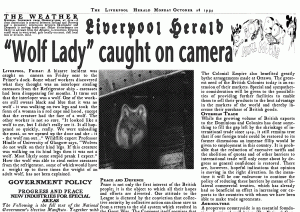
The Liverpool Herald Monday October 28 – an article that may refer to Zelf, the humanoid wolf from my forthcoming novel, Gryphonomicon Steam Submarine.
And Steampunk brings us into a world where machines are noisy and smelly and wonderful and make smoke and no one cares, clocks actually have clockwork in them, horses are beautiful and essential and aren’t in hamburgers, poetry is poetic, chastity and romance are intertwined inextricably and pornography is something polite people don’t mention (indeed – politeness is considered a virtue… indeed, virtue itself is considered a virtue…)
Steampunk hearkens back to the Victorian era – a time when monsters in literature were actually monsters (although the greatest monster is always, potentially, the human being), a time when there were still people living in villages in England who assumed that magic circles, leprechauns, and the fey lands existed, and yet people had begun wondering whether there was life on the moon and planning how to get there, and scientists did not consider it beneath their dignity to enquire into life after death, the existence of the soul, alchemy, ancient Egyptian magic, Sumerian ruins as a proof of the historicity of the first five chapters of the book of Genesis from the Bible, or ghosts and fairy abductions.
Most of all, for me, on a philosophical level, Steampunk points to a world where the advantages and benefits of Western civilisation and philosophy might be valued without making one single culture the ultimate measure of all things… (Well Denethon there may well be an inherent logical contradiction to that idea. Ahem…. Hmmm. Rats…)
(But perhaps it might not be a logical contradiction in an alternative universe…. Oops perhaps this one is the alternative universe…. Allow me to check my Chronometer.)
The danger in writing Steampunk, of course, is of creating something that concentrates only on the external elements of style, and has no real depth.
What I tried to do in Gryphonomicon Cryptogryph is to write a book in which story is the important thing, i.e. something that has a beginning, a middle and an end, in which characters act according to their character and develop, in which plot is intrinsically intertwined with character. Whether I have succeeded is up to the reader to decide.
Historical accuracy is really important to me – the alternative London in my novel is truly one that seems as though it could exist – (indeed, I did some of my research there; in London, I mean) – it took a great deal of research. Style, hopefully, is an outgrowth of story, and the various universes of my novels are almost like characters in their own right.
What is your favorite thing about steampunk?
My favorite thing about Steampunk is… dirigibles! I just love dirigibles, Rather fond of goggles too. Other things I like – the writing of Tim Powers – The Anubis Gates is splendid. And I truly enjoy Morlock Night and Infernal Devices by K W Jeter. And the Alexia Tarrabotti novels of Gail Carriger, which are a sort of paranormal brand of steampunk, or maybe a steampunk brand of paranormal. And actually, I have to confess to loving the literature of the Victorian era as well – (in no particular order) Dickens, Blake, Mary Shelley, Lord Byron, Edgar Allen Poe, Arthur Conan Doyle, George MacDonald, Kierkegaarde etc etc – and some Edwardian era writers; Chesterton, Lovecraft – and Victorian music – Beethoven, Schubert, Mendelssohn, Wagner – and… the city of London! I have spent some splendid hours exploring the lesser taverns of London and it really is a wonderful setting for a story.
One of the great pleasures of researching Cryptogryph was reading the old newspapers from the Victorian Era (it is set in 1851, the year of the Great Exhibition.) Cryptogryph goes from London to Leipzig to Venice, and I researched each of these places in great detail, making sure that I knew on which street, or canal, or part of the forest in Leipzig such-and-such an event happened.
Your favorite steampunk accessory?
My favorite steampunk accessory is my humble beret. It was given to me by a very good friend and accompanies me on all my journeys.
What turned you onto steampunk?
What sparked my interest in steampunk was… yes, dirigibles! And the writing of someone in a writers’ group of which I am a member, Carol Ryles, whose early fragments of her novel that we were critting really resonated with me. I have always loved Monty Python and the work of Terry Gilliam. I think it was reading K W Jeter’s Morlock Night, though; that really was the moment I stepped onto the Great Steampunk Dirigible.
Do you have any upcoming Steampunk stories you can tell us about?
Steam Submarine is my current project. It is the sequel to Cryptogryph, and we are in the London of 1935. King George V is King of England. The Germanischen dictator Hister is causing trouble in Europe, but there are also rumblings from beyond… Indeed, I will mention in passing that the other world, Ultima Thule, mentioned throughout Cryptogryph, is part of the story – but not at the beginning. Obviously the submarine itself is a big part of the story, but one of the main characters is a humanoid wolf from another universe – not from Ultima Thule (where the elves live), but from one of the other worlds on the World Tree. On my blog, http://deep-cogitations.blogspot.com.au I will be releasing some fragments from Steam Submarine soon for your perusal, fellow griffin friends and dirigible travellers.
Henry Lawson Hero of the Robot Revolution is another novel I’ve finished and it’s going to be released soon and is set in the same universe as my Gryphonomicon novels in a dystopian Australia. Henry Lawson, the Australian poet, writes propaganda for a government department in a different time-stream Australia. You see, Waltzing Matilda never happened – the real swagman (Hoffmeister the German revolutionary shearer) never committed suicide and , inspired to revolt against the colonial government by the imprisonment of this Hero Of The Revolution, Australia (instead of Russia) became the first Communist Republic, and New Zealand followed, which is now named Marx Zealand. At the same time, the Maori retain their independence in Marx Zealand – they have formed an independent state in the north of the north island, the Maori Monarchist Republic, which is slightly steampunk-utopian. Haha. I had a lot of fun with that.
I have also begun the sequel to Steam Submarine, set a few years afterwards, but the name of that book has not yet been decided. The evil reign of Hister is at its full bloom and he has begun building machines to invade the other worlds.
Who is your favorite character of all from one of your Steampunk stories?
I think my favorite character in Gryphonomicon Cryptogryph is Madgwint the griffin. I was rereading the part where he gets drunk on mead in Leipzig the other day, and (if it’s not too immodest to say so) I really enjoyed it – it was a very, very hard section to write actually!
Or maybe Mr. Ravencaw, Jonathan and Amelia’s ward. He is grim in a terribly Victorian way.
Hmm. I quite like the alternate Henry Lawson too in Henry Lawson Hero of the Robot Revolution. And the alternate Hannah Thornburn.
Actually, perhaps my favourite character so far is the Wolf Lady, Zelf, in Steam Submarine, my forthcoming novel. That’s the book I’m working on at the moment.
What’s the hardest thing about creating a Steampunk universe?
The research is the hardest part of creating a realistic Steampunk Universe. Chronometers and Time Displacement Devices that can cross over to alternate universes are so hard to come by, and, as the saying in Dithingstump goes, “It’s not easy to get to Ultima Thule.”
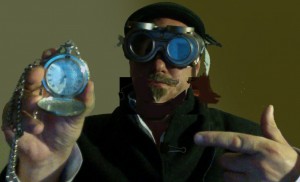
And I have read so many articles from old newspapers! Finding out the name of a particular street in a particular year can be quite difficult, or making sure that the building on the Liverpool wharves that the book is talking about actually existed on that particular date, and what the warehouses looked like and whether the hospital was still there in that year. And making the maps and the illustrations historically accurate, including the things that don’t exist in our timestream. I know it’s supposed to be fantasy! But it should feel real – and I don’t feel it’s real unless I can justify every detail*. (*Ahem – or maybe it is real? Who can really say?)
Actually, no, that’s not the hardest part. Sitting down and writing every day is probably the hardest part. Just getting started sometimes – once I get into it I can get involved and write for days. But sometimes getting started is really hard, because my brain sometimes seems even more empty than the page at the start. (Opportunity for someone to step in here with low class insult.)
What’s the easiest thing about creating a Steampunk universe?
The easiest thing about creating a realistic Steampunk Universe is…. Um… actually I don’t think anything about writing is easy but it’s so satisfying to have a finished book on your desk, dammit! (Oh, but then again, every now and then I get these wierd dreams that give me ideas for my books… Thankyou, Unknown Deity! )
What does steampunk allow you to do as a writer that no other genres can?
Now – about what Steampunk enables me to do – I have written three high fantasy books too (mind you they are set in the same world as Cryptogryph, albeit 10,500 years earlier), and I will cheat a little on this question – I actually think speculative fiction as the genre overarching Steampunk offers the opportunity to offer an escape from the mundane, everyday world, whilst reflecting on the human condition in a metaphorical way. Thus speculative fiction is ‘more relative than this’ – to quote an obscure line from Hamlet in a questionable context – for instance in a book if someone is racist against a werewolf, or a dwarf against an elf it can be a reflection of racism in our world, really, in what is a less offensive and confronting way for readers. And so on, and so on, this applies to every kind of moral, ethical and philosophical issue. Not that I want people to go through my books looking for ‘issues’ or ‘ideas’ – they’re not written to be read like that – they’re meant to be thrilling stories. But I think one’s personal philosophical outlook inevitably influences one’s writing – and I believe that this is what gives depth to any book, actually, but speculative fiction offers the opportunity for metaphors of much greater enormity! (And in Steampunk a whole universe can be a metaphor…)
By the way, I must comment a little more on what I just said. I don’t think the mundane everyday world is quite so mundane and everyday as it might seem to be – any one of us at any time could find ourselves in the middle of a real adventure – and I am quite certain that the things we can see are just a fraction of what actually exists – Ah! My chronometer. Time is getting short and I must~
The manuscript ends here.
Since Robert Denethon appears to have disappeared again, we may as well give you the website addresses where you can at least find some tenuous evidence of his existence.
His website about Griffins: http://griffinfantasy.com
Robert’s Blog, Deep Cogitations: http://deep-cogitations.blogspot.com.au
The Publisher, Submarine Media’s site: http://www.submarinemedia.com.au

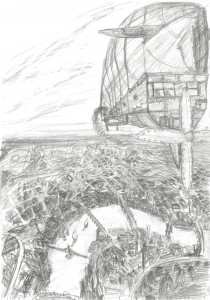



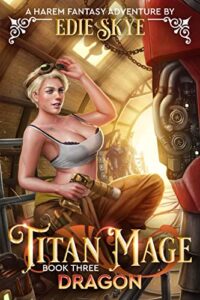

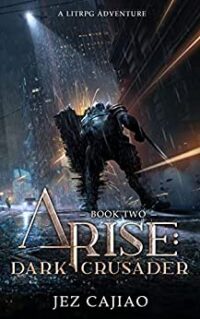
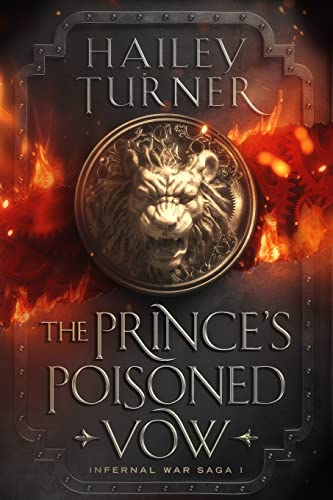



What a brlliant summary of your work and things that inspire you, Robert. I shall immediately hie me to http://www.submarinemedia.com.au to purchase my copy!
Best wishes Satima. You might do better to go to Amazon and type Denethon in to the search field! Submarine Media does not sell the books directly from their site as yet.
Lovely interview, Robert! Wishing you all success with the novel(s). 🙂
Thankyou so much Joanna! ~ you are a truly poetic soul and a great writer, and your best wishes mean a lot to me. 🙂
Robert
OMG! I love steampunk. So glad I found your site. You commented to my topic post on Blogger Lift. I’m subscribed through email. Would love a follow back.
Thanks a lot Jeanette! I’m just having a look at your book on Amazon right now – might get it for my kindle. Looks rather interesting.